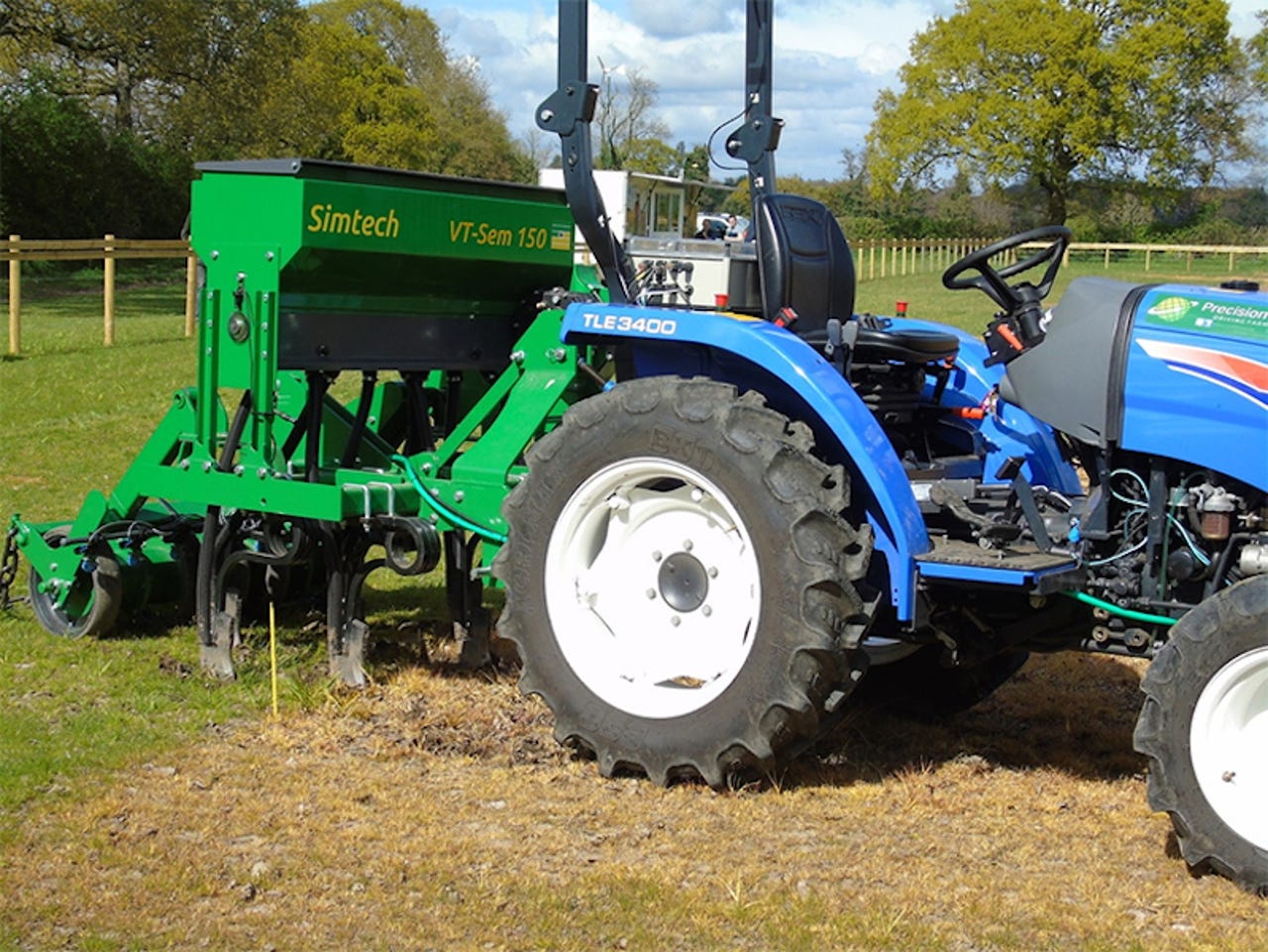The future of food includes self-driving tractors, precision agriculture, robots, AI, and IoT

Closing the hunger gap
The world's population is expected to reach over 9 billion by the year 2050. This poses a unique situation for farmers as they attempt to find viable methods for producing enough food to feed everyone. Luckily, technology is growing almost as fast as the human race and can hopefully help prevent a food shortage crisis. The following farms are using IoT, AI, precision farming, and other modern methods to streamline operations and increase crop yield.
Last-minute equipment checks using an iPad
The John Deere test facility in Bondurant, IA is taking advantage of technologies like GPS, self-driving tractors, advanced planters and sprayers, AI, and IoT to find the best ways to harness land and increase crop production.
John Deere test farm manager Marcus Hall makes last-minute system checks on a new row crop tractor from an iPad. (Caption by Natalie Gagliordi)
Read the full cover story by Natalie Gagliordi: How self-driving tractors, AI, and precision agriculture will save us from the impending food crisis
Preparing for a field test
John Deere test farm manager Marcus Hall prepares for a field test in Bondurant, IA. (Caption by Natalie Gagliordi)
Read the full cover story by Natalie Gagliordi: How self-driving tractors, AI, and precision agriculture will save us from the impending food crisis
Checking system connectivity
Marcus Hall checks system connectivity on one of John Deere's newest row crop tractors. (Caption by Natalie Gagliordi)
Read the full cover story by Natalie Gagliordi: How self-driving tractors, AI, and precision agriculture will save us from the impending food crisis
Testing out new planters and sprayers
John Deere performs field tests on its newest planters and sprayers at its test farm in Bondurant, IA. (Caption by Natalie Gagliordi)
Read the full cover story by Natalie Gagliordi: How self-driving tractors, AI, and precision agriculture will save us from the impending food crisis
The John Deere row crop tractor
The backend of John Deere's row crop tractor is prepared for planting. (Caption by Natalie Gagliordi)
Read the full cover story by Natalie Gagliordi: How self-driving tractors, AI, and precision agriculture will save us from the impending food crisis
Error alert
Sensors on a John Deere row crop tractor trigger an error alert on an in-cab screen when a part of the system malfunctions. (Caption by Natalie Gagliordi)
Read the full cover story by Natalie Gagliordi: How self-driving tractors, AI, and precision agriculture will save us from the impending food crisis
Using GPS to avoid crop overlap
With advanced GPS, a tractor operator can tell which rows have been planted to avoid overlap. (Caption by Natalie Gagliordi)
Read the full cover story by Natalie Gagliordi: How self-driving tractors, AI, and precision agriculture will save us from the impending food crisis
John Deere crop sprayer
The massive arms of a John Deere crop sprayer unfold like a transformer. (Caption by Natalie Gagliordi)
Read the full cover story by Natalie Gagliordi: How self-driving tractors, AI, and precision agriculture will save us from the impending food crisis
Meet Harry
Small Robot Company and HandsFree Hectare, two UK-based projects via Harper Adams University, are using methods such as IoT, autonomous robotics, modern photography methods, and AI to take precision agriculture to the next level; through these technologies, the projects hope to provide solutions to the imminent food shortage issue.
This is an early design for Harry, Small Robot Company's precision drilling and planting robot. (Caption by Charles McLellan)
Read the full cover story by Charles McLellan: Smart farming: How IoT, robotics, and AI are tackling one of the biggest problems of the century
Introducing Rachael
Rachael, SRC's prototype robot, is used for testing control systems and gathering AI training data. (Caption by Charles McLellan)
Read the full cover story by Charles McLellan: Smart farming: How IoT, robotics, and AI are tackling one of the biggest problems of the century
Haraka
SRC's precision-planting mechanism will be based on the haraka, a simple punch-planting device. (Caption by Charles McLellan)
Read the full cover story by Charles McLellan: Smart farming: How IoT, robotics, and AI are tackling one of the biggest problems of the century
Agri-Tech East REAP Conference
The latest prototype of Small Robot Company's Harry, a precision drilling and planting robot, at the Agri-Tech East REAP Conference in November 2018. Pictured are: Belinda Clarke (left), Director of Agri-Tech East, and Sam Watson Jones (right), co-founder of Small Robot Company. (Caption by Charles McLellan)
Read the full cover story by Charles McLellan: Smart farming: How IoT, robotics, and AI are tackling one of the biggest problems of the century
Look, no hands
The HandsFree Hectare project grows crops using autonomous machinery. No human has set foot in the one-hectare field for two seasons. (Caption by Charles McLellan)
Read the full cover story by Charles McLellan: Smart farming: How IoT, robotics, and AI are tackling one of the biggest problems of the century

Tractor meets drill
A small, lightweight seed drill, normally used for planting between rows of vines, was used to sow the barley crop. (Caption by Charles McLellan)
Read the full cover story by Charles McLellan: Smart farming: How IoT, robotics, and AI are tackling one of the biggest problems of the century
Autonomous combine
An autonomous combine--again, smaller and lighter than conventional farm machinery--harvesting HFHa's first crop in September 2017. (Caption by Charles McLellan)
Read the full cover story by Charles McLellan: Smart farming: How IoT, robotics, and AI are tackling one of the biggest problems of the century
Farming equipment at Purdue University
The Agronomy Center for Research and Education (ACRE) at Purdue University in West Lafayette, IN along with Land O'Lakes/WinField United are exploring how the implementation of big data, satellite imagery and drones, IoT sensors, and genetic testing can lower agricultural costs and improve the overall farming process.
Farm equipment at the Agronomy Center for Research and Education at Purdue University. (Caption by Teena Maddox)
Read the full cover story by Teena Maddox: Agriculture 4.0: How digital farming is revolutionizing the future of food
Test fields
Test fields at the Agronomy Center for Research and Education at Purdue University. (Caption by Teena Maddox)
Read the full cover story by Teena Maddox: Agriculture 4.0: How digital farming is revolutionizing the future of food
Testing plant growth
Testing variables in plant growth at the Agronomy Center for Research and Education at Purdue University. (Caption by Teena Maddox)
Read the full cover story by Teena Maddox: Agriculture 4.0: How digital farming is revolutionizing the future of food
Touring the facility
Jim Beaty (right), superintendent of the Purdue Agronomy Center, doing a tour of his facility. (Caption by Teena Maddox)
Read the full cover story by Teena Maddox: Agriculture 4.0: How digital farming is revolutionizing the future of food
Testing the equipment
Testing high-tech farm equipment at the Agronomy Center for Research and Education at Purdue University. (Caption by Teena Maddox)
Read the full cover story by Teena Maddox: Agriculture 4.0: How digital farming is revolutionizing the future of food
Farming technology
Technology in place at the Agronomy Center for Research and Education at Purdue University. (Caption by Teena Maddox)
Read the full cover story by Teena Maddox: Agriculture 4.0: How digital farming is revolutionizing the future of food
Also see
- The future of food (ZDNet/TechRepublic special feature)
- How 5G will impact the future of farming and John Deere's digital transformation (ZDNet)
- Robotic indoor farms can grow food anywhere, anytime (ZDNet)
- Farming for the future: How one company uses big data to maximize yields and minimize impact (TechRepublic)
- Drone technologies could increase farmers' productivity by 500 percent (TechRepublic)
- Walmart now uses blockchain to trace food, will others follow? (TechRepublic)
- More must-see food tech coverage (TechRepublic Flipboard magazine)